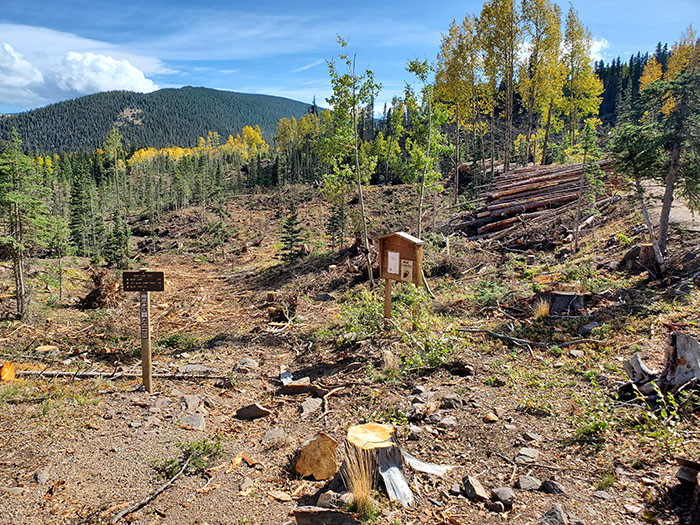
In winter 2022, the Sangre de Cristo Range near Cuchara, Colo., in southern Huerfano County and northern Las Animas County, experienced a powerful wind event, toppling patches of hundreds of acres of mostly spruce and fir forest across miles of mountainous terrain. Unfortunately, this blowdown event caused parts of the San Carlos Ranger District to close to the public due to safety considerations. The event significantly affected multiple important and well-loved recreational areas within parts of the San Carlos District of the San Isabel National Forest. Access to trails, forest roads, campgrounds and the popular high-elevation Blue and Bear Lakes Campgrounds were affected as thousands of trees toppled and snapped in the high winds, resulting in a hazardous landscape and a challenging problem for forest land managers to restore safe access to the area and address forest health issues.
Blowdowns and beetles
Forest blowdown events are periodically common in the western United States, and there are certain forest pests, such as the native spruce beetle (Dendroctonus rufipennis), that capitalize on blowdown events to take advantage of trees that are stressed, damaged and uprooted. Engelmann spruce (Picea engelmannii) dominate the forested mountains of Colorado above 9,000 feet of elevation, and this blowdown event occurred in the heart of the spruces’ range. When trees are stressed by a variety of factors, or in this case, damaged, snapped or uprooted by strong winds, they emit chemicals that spruce beetles respond to. These resulting blowdown patches are buffet tables for the beetles, as they can complete their lifecycles in these impacted trees. If the surrounding stands of live spruce trees are stressed, they too may attract beetles as their population grows. Healthy forests are key to resisting infestations. Strategic forest management is necessary to help reduce the expansion of beetle impacts.
Prioritizing public safety

After the blowdown event, there was a need to reopen the area to the public, while also addressing the forest health impacts associated with the threat of spruce beetles, and mitigating firefighter and public safety concerns in the event of future wildfire in the area. The U.S. Forest Service partnered with the Colorado State Forest Service (CSFS), using the Good Neighbor Authority (GNA), which uses state forestry agencies’ staff and experience to help prepare and manage the implementation of forest treatments on USFS lands. The result was a 94-acre project that removed material from the area campgrounds and created a fuelbreak along the roadway to provide for safe egress of the public in the event of a wildfire in the area.
The project was ultimately awarded to Miller Timber Services, and the CSFS administered and oversaw the work. Miller Timber Services employed sophisticated logging equipment that could operate on steep slopes while minimizing negative impacts to soils, water quality and surrounding infrastructure. The wind-damaged and standing conifer trees greater than five inches in diameter were removed to create a 500-foot wide, 1.8-mile-long fuelbreak on both sides of US Forest Road 422, including Blue and Bear Campgrounds, and part of US Forest Road 436 (locally known as the Trinchera Road).
Removing spruce trees greater than five inches in diameter helps reduce the potential of spruce beetle impacts, as the beetle prefers larger diameter trees to feed and reproduce in. This also helps break up the continuity of the forest cover, ultimately giving fire management resources a strategic location to help mitigate risk to firefighters and the public when a fire starts in the area. Due to its lower level of susceptibility to fire, aspen trees were left throughout the fuel break, which are sun loving and vigorously respond to disturbance and openings in their surroundings. Therefore, in the coming years, the roadside will be lined with breathtaking golden aspen trees during autumn, with a backdrop of incredible views of the Sangre de Cristo Range and the Spanish Peaks.
In total, 196 truckloads of timber were hauled from the site and processed into lumber at the nearby Blanca Forestry Products sawmill just outside the town of Blanca, Colo., in the San Luis Valley. The project also produced more than 100 cords of firewood, which is currently piled along US Forest Road 422 ready to be sold by the USFS to the public. Fuelwood permits can be purchased from the USFS offices in La Veta, Pueblo, Westcliffe or Cañon City, and they are $10/cord with a minimum purchase of three cords and a maximum purchase of 10 cords/household.
Next steps
The San Carlos Ranger District will assess the needed repairs to the Bear Lake and Blue Lake Campgrounds this spring to prepare for opening both campgrounds in a limited capacity for the 2024 summer season. Access to the area is limited due to the deep snow in the area, and the number of sites to be open, as well as the timing of the opening will depend on what is found during the assessments this spring. Information will be released by the San Carlos Ranger District as more information is known.
Considerable blowdown-impacted acres are still found along US Forest Road 436 (Trinchera Road) as it heads to the south toward tree line, making the road impassable and closed for now. An additional joint project with the CSFS is underway to address the Trinchera Road beginning this summer. The U.S. Forest Service and CSFS request that the public not cut trees in this area as it will be part of an upcoming timber sale. There are ample fuelwood opportunities in this area, and machinery will be necessary to remove the downed trees from the Trinchera Road.
The San Carlos Ranger District and the CSFS appreciate the understanding and support of the public, as these agencies continue to adapt to challenges by planning and managing public natural resources for the benefit of current and future generations.

